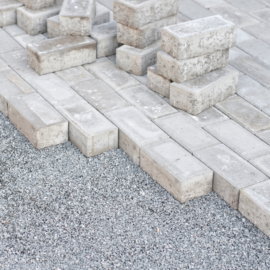Retaining Walls Services London
A retaining wall is a structure that is designed to withstand the lateral pressure and retain soil or soil materials. There are many types of materials that can be used to create retaining walls like concrete blocks, poured concrete, treated timbers, rocks or boulders.
How Retaining Walls Work
A retaining wall is intended to hold back soil when there is a drastic elevation change. There are four basic types of retaining walls:
Gravity walls hold back the earth by the mass of the wall material. A retaining wall that relies solely on its own weight versus the bearing load weight to stand up is called a gravity wall. They could be a stack of large rocks, or more formal like pavers. They can fail easily and should be used only for short slopes of 3 feet or less.
Piling walls (Secant Pile Walls) are formed by constructing intersecting reinforced concrete piles. Secant Pile Walls are usually installed as support systems for deep foundations, retaining elements, load-bearing walls and deep foundations for engineering constructions.
Cantilever walls are similar to piling walls. However, they get added strength from an internal stem of steel-reinforced, cast-in-place concrete or mortared masonry, increasing their capacity to stabilise pressure.
Anchored walls are the strongest type of retaining wall, and can be combined with any other techniques. As the name implies, it has additional strength using cables or other stays anchored in the rock or soil behind it.

Can Retaining Walls Be Repaired
Whether your retaining wall is built from stone, block, concrete or wood, it can begin to lean. A professional can quickly stabilise the wall and in many cases pull it back into its original position. Most retaining walls can be rehabilitated despite their initial issues, so the first task is identifying what is the cause for the failure. Our team of experts are fully qualified to identify any issues with retaining walls and to formulate a plan of action to begin the repair/replacement process.
Where Retaining Walls Are Used
The main uses of retaining walls are to help prevent soil erosion, create usable beds from steep terrain and provide decorative or functional landscaping features. They may be independent structures or may be a part of wider construction works. They provide support to the terrain where the soil’s angle of repose is exceeded and it would otherwise collapse.
A retaining wall can convert a slope into a flat level area. This can allow for the construction of structures that otherwise couldn’t be built like a parking lot, sports field, or building. In many places around the world, whole mountainsides are cut into a series of steps supported by a series of retaining walls. Called terracing, this technique turns land that is too steep to grow crops into useful farmland.
As previously stated retaining walls are often used to create usable flatbeds in landscaping. It is a lot easier to maintain a flat area than to have to prune, mow, or plant a slope. They also provide a natural separation between turf and beds. Over time, these easy-care features can shave significant amounts from the cost of landscape maintenance.
Contacting JU Contractors for Retaining Wall Work
Contact us now to get the ball rolling on your project! J U Contractors operate throughout Kent, London, Surrey and further afield – make sure you’re following our Facebook and Instagram for regular service updates!



